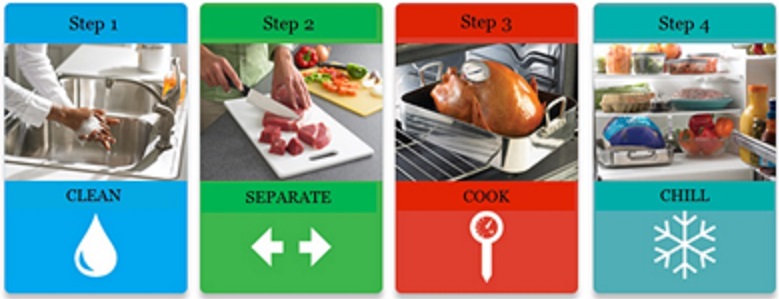Safe Food Handling Tips
Four Steps to Food Safety

Foodborne illness can strike anyone. However, some people are at a higher risk for developing foodborne illness. These include pregnant women, young children, older adults and people with weakened immune systems. If you — or someone you care for — are in one of these at-risk groups, it’s important to pay extra attention to handling food safely.
CLEAN: Wash hands and surfaces often
Bacteria can be spread throughout the kitchen and get onto hands, cutting boards, utensils, counter tops and food.
To ensure that your hands and surfaces are clean, be sure to:
- Wash your hands with warm water and soap for at least 20 seconds before and after handling food and after using the bathroom, changing diapers and handling pets.
- Wash your cutting boards, dishes, utensils and countertops with hot soapy water after preparing each food item and before you go on to the next food.
- Consider using paper towels to clean up kitchen surfaces. If you use cloth towels wash them often in the hot cycle of your washing machine.
- Rinse fresh fruits and vegetables under running tap water, including those with skins and rinds that are not eaten.
- Rub firm-skin fruits and vegetables under running tap water or scrub with a clean vegetable brush while rinsing with running tap water.
- With canned goods, remember to clean lids before opening.
SEPARATE: Separate raw meats from other foods
Cross-contamination can occur when bacteria are spread from one food product to another. This is especially common when handling raw meat, poultry, seafood and eggs. The key is to keep these foods— and their juices—away from ready-to-eat foods.
To prevent cross-contamination, remember to:
- Separate raw meat, poultry, seafood and eggs from other foods in your grocery shopping cart, grocery bags and in your refrigerator.
- Use one cutting board for fresh produce and a separate one for raw meat, poultry and seafood.
- Never place cooked food on a plate that previously held raw meat, poultry, seafood or eggs.
- Don’t reuse marinades used on raw foods unless you bring them to a boil first
COOK: Cook to the right temperature
Food is safely cooked when it reaches a high enough internal temperature to kill the harmful bacteria that cause illness. Refer to the Safe Cooking Temperatures Chart for the proper internal temperatures.
To ensure that your foods are cooked safely, always:
- Use a food thermometer to measure the internal temperature of cooked foods. Check the internal temperature in several places to make sure that the meat, poultry, seafood, eggs or dishes containing eggs are cooked to safe minimum internal temperatures as shown in the Safe Cooking Temperatures Chart.
- Cook ground meat or ground poultry until it reaches a safe internal temperature. Color is not a reliable indicator of doneness.
- Cook eggs until the yolk and white are firm. Only use recipes in which eggs are cooked or heated thoroughly.
- When cooking in a microwave oven, cover food, stir, and rotate for even cooking. If there is no turntable, rotate the dish by hand once or twice during cooking. Always allow standing time, which completes the cooking, before checking the internal temperature with a food thermometer. Food is done when it reaches the safe minimum internal temperature.
- Bring sauces, soups and gravy to a boil when reheating.

CHILL: Refrigerate foods promptly
Refrigerate foods quickly because cold temperatures slow the growth of harmful bacteria. Do not over-stuff the refrigerator. Cold air must circulate to help keep food safe. Keeping a constant refrigerator temperature of 40°F or below is one of the most effective ways to reduce the risk of foodborne illness. Use an appliance thermometer to be sure the temperature is consistently 40°F or below and the freezer temperature is 0°F or below.
To chill foods properly:
- Refrigerate or freeze meat, poultry, eggs, seafood and other perishables within 2 hours of cooking or purchasing. Refrigerate within 1 hour if the temperature outside is above 90°F.
- Never thaw food at room temperature, such as on the counter top. Food must be kept at a safe temperature during thawing. There are three safe ways to defrost food: in the refrigerator, in cold water, and in the microwave. Food thawed in cold water or in the microwave should be cooked immediately.
- Always marinate food in the refrigerator.
- Divide large amounts of leftovers into shallow containers for quicker cooling in the refrigerator.
- Use or discard refrigerated food on a regular basis. Follow the recommendations in the Refrigerator & Freezer Storage Chart at
http://www.fda.gov/downloads/Food/ResourcesForYou/HealthEducators/UCM109315.pdf
http://www.fda.gov/Food/FoodborneIllnessContaminants/BuyStoreServeSafeFood/ucm255180.htm
http://www.fda.gov/downloads/Food/FoodborneIllnessContaminants/BuyStoreServeSafeFood/UCM440123.pdf


Open Every Day:
Monday: 10am – 5pm
Tuesday: 10am – 5pm
Wednesday: 10am – 5pm
Thursday: 10am – 5pm
Friday: 10am – 5pm
Saturday: Closed
Sunday: Closed
BAKERY LOCATION
619C 1st Avenue North, Saskatoon, SK, S7K 1X7, Canada
TELEPHONE:
Telephone: +1 (306) 881-3449
EMAIL:
Email: info@beerain.ca
